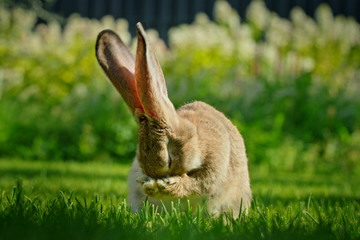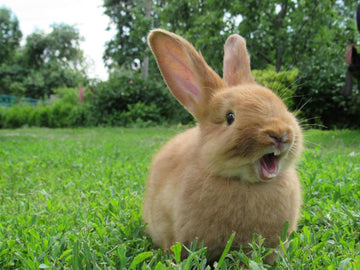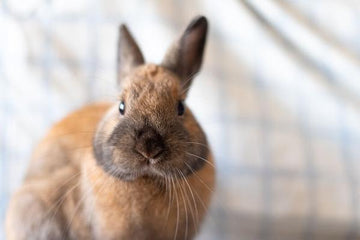Rabbit Cage Ideas That Go Beyond the Standard Cage
One of the things that helps keep your rabbit both happy and health is a well-thought-out living space!
Whether you’re new to bunny parenting or looking to upgrade your current setup, your rabbit’s cage should be more than just a box or cage with hay. It should be their safe place, their play zone, and their cozy retreat—all rolled into one!
Click Here to Shop Rabbit Products.

That doesn’t mean you need to break the bank or start building from scratch. With a few clever upgrades or repurposed materials, you can turn any space into a bunny paradise. Let’s dig into some creative rabbit cage ideas that blend comfort, safety, and style.
What Makes a Good Rabbit Cage?
At Rabbit Hole Hay, when we say "rabbit cage," we’re using the term loosely. We believe a rabbit’s living space should be so much more than a cage—it should be a secure area where they can explore, play, and feel safe.
While there are some circumstances where traditional cages are used, we advocate for more spacious, flexible setups. These allow for easier customization and can be expanded or rearranged as your rabbit’s needs change. Our goal is to help you create a home environment that puts your rabbit’s wellbeing first.
The general recommendation is creating a space that is four times bigger than the rabbit's size. This gives your bunny enough room to move around, however the larger the better, especially for larger breeds like Flemish Giants or even energetic Rex rabbits.
Ventilation is just as important. Solid plastic bins or aquariums trap odors and ammonia from urine. A better option is an open-sided wire frame with a solid floor. Add fleece liners or mats to make it soft and safe for delicate feet.
Choosing the Right Location
Where you place the cage is just as important as what it’s made of. Rabbits are social creatures, so they enjoy being near the action. Also, make sure it’s a spot where you can keep an eye on them. Rabbits are prey animals and tend to hide discomfort or illness.
The more often you see them, the easier it is to catch anything unusual early. So try setting up the cage in a spot where your family spends time, like living rooms, home offices, or a cozy corner of the kitchen.
Skip areas that are too drafty or get direct sunlight for hours at a time. Rabbits are sensitive to temperature changes, and they can overheat quickly. Keep them away from high-traffic walkways and loud noises like washers or TV speakers.
Indoor Rabbit Cage Ideas
1. Using Pet Playpens as Rabbit Cages
One of the most popular rabbit cage ideas for indoor homes is the pet exercise pen. Originally designed for dogs, these pens offer a large, customizable area that’s easy to clean and move around. They’re ideal for both temporary setups and long-term enclosures.

Look for pens that are at least 30 inches tall, especially if your rabbit is an escape artist. Most buns can clear shorter barriers in a single jump. Metal pens work best, as they’re chew-resistant and provide proper ventilation. Avoid any pens with sharp wire edges or exposed plastic clips.
You can arrange the pen in a square, rectangle, or even an L-shape to fit your space. Lay down a washable rug or fleece blankets to protect your floors and prevent slipping. Add a litter box, a hay feeder, a water bowl, and a few hideouts to complete the setup. If you're working with hardwood or carpet, place a waterproof layer underneath to catch accidents.
2. Large Dog Crates as Rabbit Enclosures
Dog crates offer another solid solution. Their sturdy frame, wide doors, and removable trays make them great for rabbit care. Many owners use them as a secure base attached to a larger x-pen or free-roam space. The crate becomes the rabbit’s bedroom—a place to nap, eat, and hide.
Choose a crate that's at least 42 inches long. This size gives medium to large rabbits space to stretch out fully. Line the bottom with a soft mat or fleece, and make sure the door stays open during supervised playtime. Some rabbits even learn to return to their crate when they’re tired or want alone time.
One benefit of using crates is that they’re easy to move. If you travel or need to rearrange furniture, a crate can be relocated without disassembling the entire setup. Just remember that it shouldn’t be the only space your rabbit has access to—always pair it with exercise time or an attached play area.

3. Rabbit Cage Ideas for Unused Rooms and Closets
If you’ve got a spare laundry room, large closet, or underused guest room, you’ve got prime real estate for a rabbit cage upgrade. These spaces give rabbits room to explore while keeping them contained and safe. With a few simple changes, you can transform these forgotten corners into full-time rabbit habitats.
Converted Laundry Rooms
A spare or unused laundry room can make an excellent rabbit enclosure—especially if the washer and dryer are no longer in use, since the noise and vibrations from running machines can be stressful for rabbits. These spaces are often quiet and tucked away from high-traffic areas, which helps your rabbit feel safe and secure.
These rooms usually have washable floors, making clean-up easy. You’ll want to bunny-proof the space by covering outlets, securing cords, and blocking off any gaps behind appliances. Set up zones for eating, resting, and using the litter box.
Add tunnels, cardboard boxes, and chew toys for enrichment. If the room has windows, be sure your rabbit can escape direct sunlight or strong drafts—a portable fan or blackout curtain can help regulate the temperature year-round.
Closets and Alcoves
Turning a closet into a rabbit space is easier than you might think. Remove the door (or keep it open) and lay down a mat or rug. Use shelving or storage cubes to divide the area into sections—one for the litter box, one for food and water, and another for lounging.
If the closet has sliding doors, make sure they can’t accidentally close on your rabbit. It’s a good idea to keep a baby gate or playpen panels across the entrance to keep the area visible and breathable.
Unused Bedrooms
For those lucky enough to have a spare bedroom, this might be the best setup of all. You can give your rabbit full free roam of the room without sacrificing the rest of your home. Add a gate or door barrier to separate the space while still letting in light and airflow.
Use furniture like low bookshelves or cube storage to break up the space and make it more interesting. Rabbits enjoy areas where they can duck behind something or hop onto a platform. Just be sure all furniture is stable and that cords, plants, and small objects are out of reach. The Humane Society offers some great guidelines for rabbit-proofing indoor areas like these.

When to Use X-Pens, Baby Gates, and Room Dividers
If you're not ready for full free-roam living, baby gates and x-pens can help create a “semi-free” lifestyle. These tools give your rabbit extra space during the day while keeping them safe from household hazards. You can block off hallways, doorways, or a section of your living room with ease.
Look for gates without horizontal slats your rabbit can climb. Pressure-mounted models are safer than tension rods, and wood or metal options are more durable than plastic. Keep in mind that rabbits can squeeze through surprisingly small gaps, so always double-check the spacing.
This setup works great for people who want to let their rabbits roam more without turning the whole house into a bunny wonderland. It also makes it easier to supervise young or newly adopted rabbits as they learn their space.
Why Bigger is Always Better
Small cages sold in pet stores are often far too cramped for any rabbit. They're marketed as homes but function more like holding pens. Over time, living in a tight space can lead to muscle atrophy, obesity, and behavior problems like cage aggression or chewing.
By getting creative and using a playpen, crate, or full room, you’re supporting your rabbit’s natural instincts. It makes them calmer, more confident, and more engaged with their environment.
Key Takeaways
At the end of the day, creating the right home for your rabbit doesn’t have to be complicated or expensive—it just needs to be thoughtful. Whether you're using a pet playpen, repurposing a large dog crate, or converting an unused laundry room or closet, the goal is always the same: give your rabbit room to move, rest, and explore.
The more space and stimulation you provide, the healthier and happier your rabbit will be. And with a little creativity, even small homes or apartments can become the perfect place for a bunny to thrive.

"Why Is My Rabbit Licking Her Own Pee?"

Rabbit Is It Low Maintenance or More Work Than You Think?

Tips to Manage Rabbit Chewing Habits






